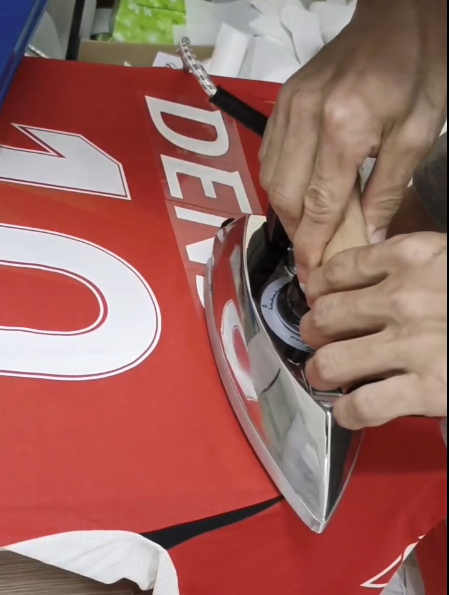- Home
- How to Fix Peeling Prints on Your Football/Soccer Jerseys
How to Fix Peeling Prints on Your Football/Soccer Jerseys
Peeling prints on football or soccer jerseys can be frustrating, diminishing the appearance and value of cherished apparel. Addressing this issue typically involves careful cleaning, proper storage, and sometimes even reapplication of graphics to restore the jersey to its original state. By taking proactive steps, individuals can extend the lifespan of their favorite jerseys and maintain their visual appeal.
Understanding the common causes of print peeling is essential for effective prevention and repair. Factors such as poor washing techniques, exposure to high heat, or the quality of the print materials all contribute to the wear and tear that leads to peeling. By being mindful of these elements, jersey owners can significantly reduce the occurrence of this problem.
Whether it’s a special match day or a casual outing, having jerseys in pristine condition is important for many fans. This article offers practical tips and strategies to fix and prevent peeling prints, ensuring that jerseys remain vibrant and ready for the next game.
Common Causes of Print Peeling
1. Excessive Additives: Using too much softening agent or silicone oil can affect the adhesive strength of the print.
2. Fabric Type: Coarse fabrics with larger textures can create gaps between the print and the fabric, leading to poor adhesion.
3. Frequent Heat Exposure: Ironing or tumble drying can weaken adhesive bonds, particularly in heat transfer prints.
4. Improper Washing: Scrubbing directly on the print or washing with the print facing outward can cause excessive friction, shortening the print’s lifespan.
5. Physical Wear: Regular use can cause abrasions. Playing in rough conditions increases the risk of print deterioration.
Remedies for Peeling Prints
Several methods exist to restore the print without compromising the fabric.
1. Using Adhesive:
If the print has come off in a large, intact piece, you can reattach it with fabric glue.
Fabric glue is a practical option, specifically designed for textiles.
Start by carefully lifting the edges of the peeling print. Apply a small amount of fabric glue under the print, ensuring even coverage. Press down firmly to ensure a strong bond.

After applying the glue, avoid moving the jersey and let it air dry completely, let the adhesive cure fully according to the manufacturer's instructions. The jersey should be washed carefully on a gentle cycle to preserve the repair. Avoid using fabric softeners, which may weaken the print.
2. Sewing:
For prints that are only partially peeling, carefully sew the edges back in place. For small cracks, you can use an iron to heat the area and help seal the cracks.
3. Steam Ironing:
Gently place a steam iron over the print to help it adhere back to the fabric using the heat from the steam.

4. Using Heat Press for Repair ( professional services )
A heat press can be an effective tool for repairing peeling prints. To start, ensure the jersey is clean and dry. Place a pressing cloth over the damaged area to protect the fabric and print.
Set the heat press to the appropriate temperature, typically between 300°F and 350°F. Gently apply pressure for about 10-15 seconds. It's crucial to monitor the progress to avoid damage. After pressing, allow the jersey to cool before inspecting the print’s adhesion. Repeat if necessary, but exercise caution and avoid excessive heat.
Maintenance Tips for Printed Jerseys
1. Washing:
Turn the jersey inside out before washing. Avoid using bleach or strong alkaline detergents. Wash in cool or lukewarm water (below 40°C / 104°F), and soak for no more than 5-6 minutes. Avoid scrubbing or rubbing the print to prevent deformation and peeling.
2. Drying:
Avoid putting your soccer jersey in an automatic dryer. The heat can cause the fabric to shrink and the colors to fade. Instead, air drying is the best method to keep your jersey in prime shape.
Do not pull or stretch the print area while drying to avoid distortion or cracking. It’s recommended to dry the jersey inside out and avoid prolonged exposure to direct sunlight to prevent yellowing.
3. Storage:
Store the jersey in a dry place to avoid moisture-related issues like peeling or stickiness.
4. Ironing:
If ironing is necessary, use a medium heat setting and steam. Avoid ironing directly over the print to prevent sticking or discoloration.
Long-Term Care and Maintenance
Proper long-term care and maintenance of football and soccer jerseys is essential for preserving their condition. By following specific practices, one can prevent issues like peeling prints and ensure the longevity of the jerseys.
Storing Jerseys Properly
Jerseys should be stored in a cool, dry place away from direct sunlight. UV rays can cause colors to fade and prints to deteriorate. Fold the jerseys neatly rather than hanging them, which can stretch the fabric and lead to distortion.
Using breathable garment bags is also beneficial. Avoid plastic bags, as they can trap moisture and lead to mildew. For additional protection, include silica gel packets in storage to absorb humidity.
Regularly rotate the jerseys in the storage space to minimize exposure to light and air. This practice helps keep colors vibrant and prevents fabric degradation from prolonged folding.
Regular Inspection and Maintenance Tips
Jerseys require regular inspection to identify any signs of wear or damage. Once a month, inspect for loose threads, fading colors, or peeling prints. Early detection can make repairs simpler and more effective.
When washing, turn jerseys inside out to protect prints and avoid high heat. Opt for a gentle cycle with cold water and mild detergent. Avoid fabric softeners, as they can break down the print adhesive.
After washing, air-dry the jerseys rather than using a dryer. If a print starts to peel, consider using a minimal heat setting with a cloth over the print to re-adhere it. Regular care will keep the jersey looking fresh for longer.

